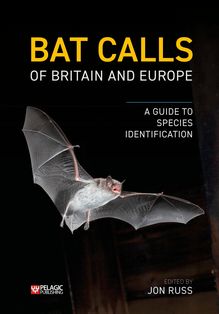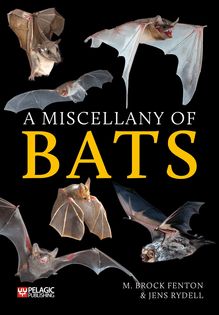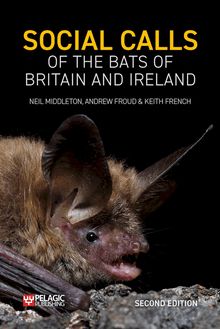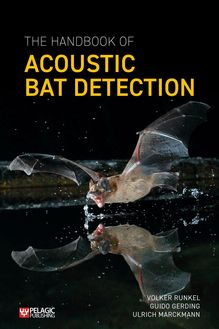-
 Univers
Univers
-
 Ebooks
Ebooks
-
 Livres audio
Livres audio
-
 Presse
Presse
-
 Podcasts
Podcasts
-
 BD
BD
-
 Documents
Documents
-
- Cours
- Révisions
- Ressources pédagogiques
- Sciences de l’éducation
- Manuels scolaires
- Langues
- Travaux de classe
- Annales de BEP
- Etudes supérieures
- Maternelle et primaire
- Fiches de lecture
- Orientation scolaire
- Méthodologie
- Corrigés de devoir
- Annales d’examens et concours
- Annales du bac
- Annales du brevet
- Rapports de stage
La lecture à portée de main
Vous pourrez modifier la taille du texte de cet ouvrage
Découvre YouScribe en t'inscrivant gratuitement
Je m'inscrisDécouvre YouScribe en t'inscrivant gratuitement
Je m'inscrisEn savoir plus
Vous pourrez modifier la taille du texte de cet ouvrage
En savoir plus

Description
Bats have long been the focus of fascination, and sometimes fear: they move faultlessly through the darkness and spend the day hanging upside down in gloomy caverns and cracks – most at home where humans are least comfortable. Bats also represent a hugely important, numerous and varied group, accounting for 20% of all mammal species worldwide. Covering their biodiversity, ecology and natural history, A Miscellany of Bats offers a hoard of insights into the lives of these creatures.
For over a quarter of a century Brock Fenton and the late Jens Rydell collaborated on projects involving bats. Here they bring together a collection of stories and anecdotes about bat research, brought to life by stunning photographs of these animals in action. Key topics include flight and echolocation, diet and roosting habits, and the complex social lives of bats. Jens and Brock also address issues of conservation and the interactions between bats and people, ranging from matters of disease to bats’ role as symbols, and our fixation with vampire bats. They explore how echolocation and flight shape batkind, from their appearance to where they go and why. Overall, this book is an entertaining and personal vision of bats’ central place in the universe. More than 150 species are covered.
Preface
Acknowledgements
1. Introducing bats
Wings and size
Blind as a bat
Catching and identifying bats
Marking and tagging
Brock’s initiation
Jens’ start
Box: What on Earth?
2. Bat wings and flight
Wing anatomy
White wings
How fast do bats fly?
Drinking
Flying antics
Box: Colour in bats
3. Seeing with sound
The perils of generalization
Basic echolocation
Why echolocate?
Echolocation and the faces of bats
Box: Beam control and bite power
4. Echolocation: a window onto bat behaviour
Biologists as eavesdroppers on bats
Insect prey
Bat communication
Air traffic control
Box: Echolocation and foraging
5. What bats eat, part 1
Learning how much a bat consumes
Some bats eat birds
Versatility
What insects do bats eat?
Specialized hunting
Trawling
Box: Diets of bats
6. What bats eat, part 2
Fruit-eating species
Bats and flowers
Box: The curious case of bananas
7. Vampire bats
8. Where bats occur and where they roost
Temperature
Bat roosts
Box: Patterning in bats
Lingering challenges
Bats up north
Box: Bat boxes
9. Social lives of bats
Reproduction
What is a colony of bats?
Food availability and social patterns
Box: Observational learning
10. How bats use space
Box: Bats get around
11. Threats to bats
Predators
Mishaps
Parasites
Wind turbines
Light pollution
A world without bats?
Global change
Box: Keeping bats away
12. Bats and people
Attitudes towards bats
Bats and disease
Bats as symbols
13. Bats as beings
A last word to the bats
Cast of bats
Notes
Index
Sujets
Informations
| Publié par | Pelagic Publishing |
| Date de parution | 10 janvier 2023 |
| Nombre de lectures | 1 |
| EAN13 | 9781784272951 |
| Langue | English |
| Poids de l'ouvrage | 20 Mo |
Informations légales : prix de location à la page 0,2100€. Cette information est donnée uniquement à titre indicatif conformément à la législation en vigueur.
Extrait
A Miscellany of Bats
A Miscellany of Bats
M. Brock Fenton and Jens Rydell
PELAGIC PUBLISHING
Published by Pelagic Publishing
20–22 Wenlock Road
London N1 7GU, UK
www.pelagicpublishing.com
Copyright © M.B. Fenton and J. Rydell 2023
All photographs © J. Rydell ( JR ), S.L. Fenton and M.B. Fenton unless otherwise noted
The moral rights of the authors have been asserted by them in accordance with the Copyright, Designs and Patents Act 1988.
All rights reserved. Apart from short excerpts for use in research or for reviews, no part of this document may be printed or reproduced, stored in a retrieval system, or transmitted in any form or by any means, electronic, mechanical, photocopying, recording, now known or hereafter invented or otherwise without prior permission from the publisher.
A CIP record for this book is available from the British Library
ISBN 978-1-78427-294-4 Paperback
ISBN 978-1-78427-295-1 ePub
ISBN 978-1-78427-296-8 ePDF
https://doi.org/10.53061/LLFU5654
Front cover images, clockwise from top left: Wahlberg’s Epauletted Fruit Bat, Hildegard’s Tomb Bat ( JR ), Daubenton’s Bat ( JR ), Yellow-winged Bat ( JR ), Hoary Bat, Common Sheath-tailed Bat ( JR )
Back cover images: Jamaican Fruit Bat, Common Vampire Bat
Title pages: Pale Spear-nosed Bat
Opposite: Heller’s Broad-nosed Bat
Contents
Preface
Acknowledgements
1. Introducing bats
Wings and size
Blind as a bat
Catching and identifying bats
Marking and tagging
Brock’s initiation
Jens’ start
Box: What on Earth?
2. Bat wings and flight
Wing anatomy
White wings
How fast do bats fly?
Drinking
Flying antics
Box: Colour in bats
3. Seeing with sound
The perils of generalization
Basic echolocation
Why echolocate?
Echolocation and the faces of bats
Box: Beam control and bite power
4. Echolocation: a window onto bat behaviour
Biologists as eavesdroppers on bats
Insect prey
Bat communication
Air traffic control
Box: Echolocation and foraging
5. What bats eat, part 1
Learning how much a bat consumes
Some bats eat birds
Versatility
What insects do bats eat?
Specialized hunting
Trawling
Box: Diets of bats
6. What bats eat, part 2
Fruit-eating species
Bats and flowers
Box: The curious case of bananas
7. Vampire bats
8. Where bats occur and where they roost
Temperature
Bat roosts
Box: Patterning in bats
Lingering challenges
Bats up north
Box: Bat boxes
9. Social lives of bats
Reproduction
What is a colony of bats?
Food availability and social patterns
Box: Observational learning
10. How bats use space
Box: Bats get around
11. Threats to bats
Predators
Mishaps
Parasites
Wind turbines
Light pollution
A world without bats?
Global change
Box: Keeping bats away
12. Bats and people
Attitudes towards bats
Bats and disease
Bats as symbols
13. Bats as beings
A last word to the bats
Cast of bats
Notes
Index
Jens Rydell at an entrance to the Hemsö Fortress in Sweden, a relict of the Cold War. Built to withstand a direct nuclear hit, part of this fortress is now used by hibernating Northern Bats. Jens and Johan were looking for sites used by swarming bats (see page 166 ). Photo by Johan Eklöf, 30 August 2017
Preface: Bats and Jens
There are more than 1,400 different species of bats worldwide. These are classified into 21 families (see table on page xi ). Here a family is a group of close relatives (in an evolutionary sense). Although we usually think of them as flying in the air, bats are land mammals, occurring everywhere except in Antarctica, the high Arctic and some remote oceanic islands.
The purpose of this book is to introduce you to the extraordinary and diverse world of bats: what they are, what they do and what we know about them. You will see that bats connect with people by way of various myths and superstitions, as well as through the science of studying them. While bats’ alleged role in the COVID-19 pandemic has not endeared them to people in general, it has highlighted the possible importance of these animals because of their astonishing capacity for neutralizing the negative impacts of some viruses.
Wings and flight are of course the two main distinctive characteristics of bats, making them easy to recognize anywhere. Bats have many other features – some basically mammalian, others relating to echolocation – but none of them is exclusive to, or characteristic of, bats. At least some species of bats have long lifespans, but their reproductive output is low, typically just one litter a year. Most species bear one young in a litter but some have twins.
Bats are not blind and do not get tangled in people’s hair. Some eat astonishing numbers of insects, and others pollinate flowers. Populations of bats may be limited by the quantity of roost spaces available, while some species readily roost in human structures from buildings to mines.
Unfortunately, suddenly and unexpectedly, co-author Jens Rydell (1953–2021) passed away just when this book was about to be finished. Johan Eklöf, one of his many former students, reflects on what Jens might have said here:
He would have kept it short, letting the reader quickly move on to the main purpose at hand: the photographs and stories behind the research. The saying ‘a picture is worth a thousand words’ is perhaps an old cliché, but still very true, and it was Jens’ motto. He photographed things nobody else saw: tiny insects, snowflakes, fossils, the beauty of darkness and of course, bats. Jens was a storyteller, and every single photo had its own narrative. He never beautified his photos. If a bat was flying outside a public restroom or in front of graffiti-sprayed walls, that was an important part of the picture too, and this often encapsulates the real beauty in his work. Jens rarely called himself a nature photographer. The camera was rather a component in his scientific toolbox, just as important as the bat detector and the little black notebook he always carried around. His bookshelves contained close to a hundred such notebooks, all the same design, ranging in date from the late 1970s to March 2021; these represent a goldmine for future generations of researchers. The same goes for the hard drives with thousands of photos, many detailed enough to study the bats as if they were in hand. In 2014, Jens published a paper (‘Photography as a low-impact method to survey bats’) on how this approach could be not only a way to study bats but perhaps even the best tool for the job. A few years ago, I suggested to Jens that he should sum up all his travels, photographic expeditions, and scientific journeys in a book, like an old-school adventurer sharing his discoveries. There were just so many tales to be told. He simply shook his head; he did not want to write about himself. But this is a book about a bat...
Some of you (hopefully reading this) are mentioned in this books’ acknowledgements. But without Jens’ presence, many names are still missing, and unfortunately the book about all of you was never realized. Instead, this is Jens’ last publication – and in a way a legacy and a summary of his contribution to bat science. Jens was proud of it, really looking forward to finally sharing the writing of a popular science book with Brock, his old friend and colleague with whom he published many scientific papers. But in Jens’ eyes, this was not a summary of a career, it was just a step on the way. He was still full of new ideas. The very same day he passed away, I had talked to him on the phone, and he said: ‘Johan, now I know what we need to do next summer…’. It concerned Northern Bats, the species he had studied his whole life, and which had comprised a major part of his doctoral study in the 1980s. He was ever thus: tireless in his curiosity about and enjoyment of bats.
Nomenclature
All species have scientific names, to increase precision of communication among scientists. Bats are no exception. Scientific names are known as binomials, hence comprising two parts: the genus name and the epithet. By convention, scientific names are always italicized. In this book we use common names in the main text and captions, relying on the Appendix to link common and scientific names.
Now we consider the names of bats in particular. Roberts’s Flat-headed Bat from southern Africa is a good place to start. Roberts was the person who first described the species, which has a flattened skull. The scientific name is Sauromys petrophilus , which roughly translates to ‘lizard-loving rock mouse’.
Common names in English are certainly easier to get a handle on for the beginner, but the lack of standardization of bats’ common names can be confusing. A bat known as the Little Brown Myotis ( Myotis lucifugus ) is called a ‘Little Brown Bat’ in some cases. Unlike birds, for instance, many bats do not have standardized common names.
Scientific names place species in a classification reflecting the organism’s evolutionary history. Sauromys petrophilus belongs to the family Molossidae (free-tailed bats) and Eptesicus fuscus belongs to the family Vespertilionidae (vesper bats). Families are made up of genera (plural of genus), genera comprise groups of species. The number of species in a genus can vary a good deal: Sauromys has one species, but Eptesicus has about 25. The families of bats (common names and scientific names) are listed in the Appendix.
After the discovery of blood-feeding bats, many bats were given scientific names with a ‘vampire’ root (e.g. Vampyrum , Vampyressa , Vampyrops ), and others were called ‘false vampire bats’. The family of bats known as ‘false vampire bats’ were thought to be like ‘real’ vampire bats and eat the blood of other animals. To date there is no evidence of this, but the name lingers on. To make matters worse, scientific names often change to reflect new ideas about boundaries between species and changes in classification. We encountered a ‘goo
-
 Univers
Univers
-
 Ebooks
Ebooks
-
 Livres audio
Livres audio
-
 Presse
Presse
-
 Podcasts
Podcasts
-
 BD
BD
-
 Documents
Documents
-
Jeunesse
-
Littérature
-
Ressources professionnelles
-
Santé et bien-être
-
Savoirs
-
Education
-
Loisirs et hobbies
-
Art, musique et cinéma
-
Actualité et débat de société
-
Jeunesse
-
Littérature
-
Ressources professionnelles
-
Santé et bien-être
-
Savoirs
-
Education
-
Loisirs et hobbies
-
Art, musique et cinéma
-
Actualité et débat de société
-
Actualités
-
Lifestyle
-
Presse jeunesse
-
Presse professionnelle
-
Pratique
-
Presse sportive
-
Presse internationale
-
Culture & Médias
-
Action et Aventures
-
Science-fiction et Fantasy
-
Société
-
Jeunesse
-
Littérature
-
Ressources professionnelles
-
Santé et bien-être
-
Savoirs
-
Education
-
Loisirs et hobbies
-
Art, musique et cinéma
-
Actualité et débat de société
- Cours
- Révisions
- Ressources pédagogiques
- Sciences de l’éducation
- Manuels scolaires
- Langues
- Travaux de classe
- Annales de BEP
- Etudes supérieures
- Maternelle et primaire
- Fiches de lecture
- Orientation scolaire
- Méthodologie
- Corrigés de devoir
- Annales d’examens et concours
- Annales du bac
- Annales du brevet
- Rapports de stage










